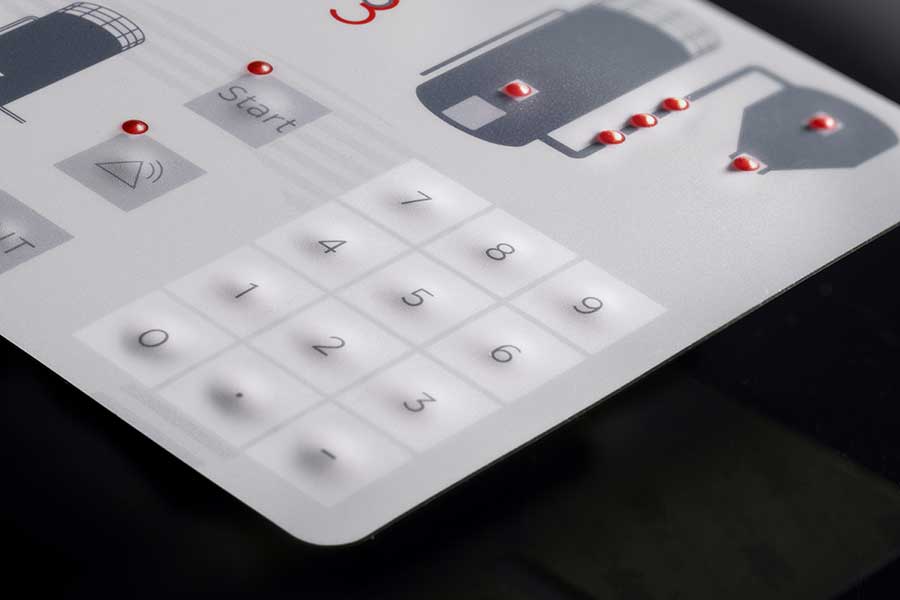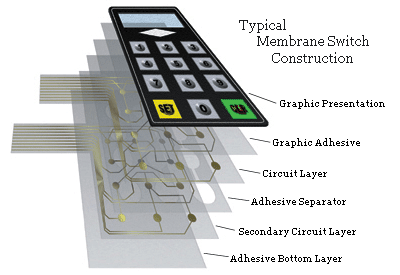A Comprehensive Guide to Membrane Switches for Product Designers
A Comprehensive Guide to Membrane Switches for Product Designers
Blog Article
Discover Exactly How Membrane Switches Feature and Their Duty in Modern Electronics
Membrane Switches stand for an innovative assimilation of technology and style within the realm of modern-day electronics, serving as necessary interfaces in countless tools. Comprehending the intricacies of Membrane switch capability and their wider ramifications in enhancing user experience welcomes further expedition right into their style, advantages, and the ingenious developments forming their future in modern technology.
What Are Membrane Switches?

Membrane switches are identified by their toughness and resistance to ecological elements, such as dirt, moisture, and severe temperature levels. They can be personalized with different graphics, shades, and tactile feedback options, boosting user experience while preserving visual appeal - membrane switches. Furthermore, the consolidation of printed circuits permits smooth combination into tools, improving general capability.
The convenience of Membrane buttons appears in their capacity to support both basic and complicated control features. They can include functions such as LED indications and touch-sensitive modern technology, satisfying specific user requirements. As modern technology remains to progress, Membrane Switches continue to be essential for enabling reliable and user-friendly customer interfaces, thus playing a pivotal role in the development of modern-day digital devices.
Elements of Membrane Switches
Membrane buttons are made up of several crucial components that interact to develop a reputable and functional user interface. The key elements consist of the graphic overlay, sticky layer, spacer layer, and conductive traces.
The graphic overlay functions as the individual interface, normally published on a versatile substratum such as polyester or polycarbonate. This layer not just gives aesthetic appeal however likewise includes tactile responses, visual signs, and safety features. Underneath the visuals overlay exists the adhesive layer, which secures the switch to the gadget and guarantees longevity versus environmental stress and anxieties.
The spacer layer is crucial for keeping the required void in between the graphic overlay and the circuit layer. When stress is used, this void allows for the activation of the button. The conductive traces, normally made from silver or carbon, create the electric paths that complete the circuit when the button is involved.
Additionally, a backing layer might be consisted of for architectural assistance and insulation. These components collaborate effortlessly, guaranteeing that Membrane switches are both user-friendly and durable, making them indispensable in various modern-day digital applications.
How Membrane Switches Work
Exactly how do Membrane Switches function successfully within electronic devices? Membrane Switches run on the principles of pressure-sensitive modern technology, using a split building that consists of visuals overlays, glue layers, and conductive components.
The layout of Membrane switches is important for their efficient operation (membrane switches). The layers are diligently crafted to provide responsive responses, toughness, and resistance to ecological elements such as dampness and dirt. The addition of domes-- little, raised areas within see page the switch-- enhances responsive feedback, offering users with an obvious click sensation upon activation
Moreover, Membrane buttons can be tailored in terms of dimension, form, and graphics, making them suitable for different applications. They are typically used in control panels, clinical devices, and customer electronic devices as a result of their sleek layout and integrity. In general, the efficient functioning of Membrane buttons is critical in improving user communication and ensuring seamless operation in contemporary electronic gadgets.

Applications in Modern Gadgets
Using their distinct design and performance, Membrane buttons have ended up being important elements in a vast array of modern digital devices. These functional interfaces are employed in customer electronic devices, commercial equipment, clinical devices, and auto controls, giving smooth customer interaction.
In customer electronics, Membrane buttons are frequently located in home appliances like microwaves, washing machines, and various other family devices, where they allow instinctive control with a sleek profile. Their low-profile layout promotes assimilation into compact devices, boosting visual charm without compromising performance.
In industrial applications, Membrane Read More Here Switches work as control board for machinery, offering sturdiness and resistance to severe atmospheres. Their ability to stand up to moisture and pollutants makes them excellent for use in manufacturing and handling markets.
Medical gadgets also take advantage of Membrane switches, which are made to be very easy to tidy and maintain, guaranteeing hygiene in medical setups. They are commonly made use of in analysis equipment, client tracking systems, and mobile clinical tools, where reliability is paramount.
Benefits of Membrane Buttons
One of the crucial benefits of Membrane buttons is their convenience, which enables them to be customized for a variety of applications throughout several sectors. These buttons can be created in numerous sizes and shapes, accommodating unique product needs while supplying smooth integration right into devices. Their slim profile allows a smooth and compact design, usually enhancing the aesthetic charm of electronic items.
One more considerable benefit is their durability - membrane switches. Membrane switches are normally resistant to dust, dampness, and chemicals, making them excellent for rough environments. This durability extends their life-span contrasted to traditional mechanical buttons, lowering the need for constant substitutes
Furthermore, Membrane Switches deal cost-effectiveness. The production procedure involves printing technologies that lessen production prices, particularly for big runs. This price, incorporated with low upkeep demands, makes them an attractive option for producers.

Conclusion
Finally, Membrane Switches represent a significant innovation in interface technology within modern electronics. Their split building and construction, pressure-sensitive procedure, and flexibility to various applications emphasize their value across several industries. The sturdiness and ecological resistance of Membrane Switches better boost their charm, making them a favored option for suppliers seeking personalized and trustworthy solutions. As the demand for resistant and instinctive interfaces continues to expand, the duty of Membrane switches fit user experience will most certainly expand.
Membrane Switches stand for an advanced assimilation of modern technology and style within the realm of contemporary electronic devices, serving as essential interfaces in countless tools.In the realm of contemporary electronic devices, Membrane Switches serve as important parts that help with individual interaction with devices. As modern technology proceeds to advance, Membrane Switches remain important for making it possible for reliable and user-friendly user interfaces, therefore playing a pivotal role in the development of modern electronic devices.
Just how do Membrane Switches function properly within digital tools? On the whole, the effective functioning of Membrane buttons is pivotal in improving customer communication and guaranteeing smooth procedure in modern digital devices.
Report this page